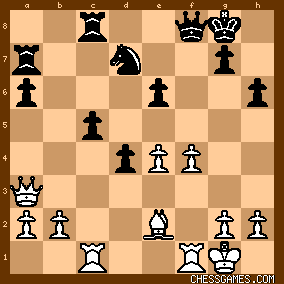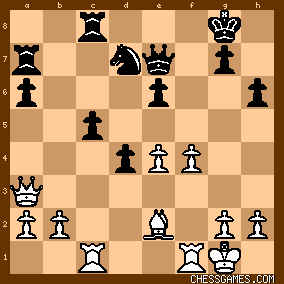|
< Earlier Kibitzing · PAGE 33 OF 33 ·
Later Kibitzing> |
| Mar-05-22 | | Canadian chesser: Thanks <RookFile> for testing 14...Qb7 on a computer (I haven't graduated to computer-assisted study yet). I'm glad the result supports the gist of my post! Apropos this move, <rigel1503> has argued: <To me, Timman's problems stem from the pawn grab on c5 before he ensures the safety of his king. Instead of 15. dxc5, why not 15. O-O. I don't see the need for rushing dxc5. Eg: 15. O-O c4 16. Qd6 Nc6 17. Ne5 Nxe5 18. Qxe5 Qc7 19. f4 Qxe5 20. fxe5 leaves White dominant due to Black's bad bishop, wooden inflexible pawn centre and cramped position.> However, Neil McDonald in his analysis of Timman vs Geller, 1973 is convincing in saying 15.dxc5 is forced "Or else 15...c4 shuts out the white pieces." (Page 47) |
|
| Mar-05-22 | | Olavi: McDonald is quoting from Geller's analysis, in English in his Pergamon Press games collection The Apllication of Chess Theory. Of course the ideas are well known. |
|
| Apr-06-22 | | jerseybob: <fredthebear: The Ukrainians have resisted being controlled by the Russian empire since 1917. The Ukraine gained it's independence in 1991 when the U.S.S.R. dissolved. The struggle for autonomy continues:> Very prescient post! |
|
| May-12-22 | | Herr Stauffenberg: If 41. ...Qg8
41...Qg8 42. Rxh6+ Rh7 43. Qf6+ Qg7 44. Rxh7+ Kxh7 45. Bd3+ Kh8 46. Qd8+ Qg8 47. Qxc7 |
|
| May-16-22 | | Herr Stauffenberg: <Canadian cheser> 16. Qd6 ??? Why not eat enemy Queen? |
|
| Jun-20-22 | | CapablancaDisciple: The times for this game from a website called crackteam.org: <<Game 6, July 23rd, 1972 Fischer Spassky
White Black
1. c4 (0:08) e6 (0:02)
2. Nf3 (0:11) d5 (0:03)
3. d4 (0:11) Nf6 (0:03)
4. Nc3 (0:11) Be7 (0:03)
5. Bg5 (0:11) 0-0 (0:04)
6. e3 (0:12) h6 (0:04)
7. Bh4 (0:13) b6 (0:08)
8. cxd5 (0:13) Nxd5 (0:08)
9. Bxe7 (0:14) Qxe7 (0:08)
10. Nxd5 (0:14) exd5 (0:08)
11. Rc1 (0:14) Be6 (0:09)
12. Qa4 (0:14) c5 (0:12)
13. Qa3 (0:14) Rc8 (0:16)
14. Bb5 (0:15) a6 (0:19)
15. dxc5 (0:19) bxc5 (0:23)
16. 0-0 (0:20) Ra7 (0:36)
17. Be2 (0:23) Nd7 (0:52)
18. Nd4 (0:28) Qf8 (1:11)
19. Nxe6 (0:39) fxe6 (1:11)
20. e4 (0:42) d4 (1:13)
21. f4 (0:47) Qe7 (1:19)
22. e5 (0:51) Rb8 (1:23)
23. Bc4 (1:02) Kh8 (1:33)
24. Qh3 (1:03) Nf8 (1:36)
25. b3 (1:08) a5 (1:36)
26. f5 (1:12) exf5 (1:38)
27. Rxf5 (1:12) Nh7 (1:42)
28. Rcf1 (1:15) Qd8 (1:48)
29. Qg3 (1:20) Re7 (1:54)
30. h4 (1:28) Rbb7 (1:57)
31. e6 (1:38) Rbc7 (1:59)
32. Qe5 (1:47) Qe8 (2:05)
33. a4 (1:48) Qd8 (2:12)
34. R1f2 (1:53) Qe8 (2:12)
35. R2f3 (1:53) Qd8 (2:12)
36. Bd3 (1:57) Qe8 (2:16)
37. Qe4 (1:58) Nf6 (2:18)
38. Rxf6 (1:58) gxf6 (2:18)
39. Rxf6 (1:58) Kg8 (2:25)
40. Bc4 (1:59) Kh8 (2:28)
41. Qf4 (2:04) 1-0
The time control was 40 moves in 2 1/2 hours, and 16 moves per hour thereafter.> > |
|
| Jul-06-22 | | N.O.F. NAJDORF: 'Tal was a Latvian.'
Tal no more had Latvian blood than he had Russian blood. He was Jewish on both sides and his original family name is said to have been Blumenthal, which is not exactly a Latvian name. I was always irritated by people calling anyone in the Soviet Union a Russian. Fischer himself called the entire Soviet chess elite 'the Russians' and Dick Cavett, when interviewing him, although pronouncing 'Tigran Petrosian' perfectly, wrongly described Petrosian as a Russian. |
|
| Jul-12-22 | | thegoodanarchist: Fischer's first win of the match with the white pieces. Interesting that he won twice with black before this game. |
|
Jul-13-22
 | | Joshka: <N.O.F. NAJDORF> Karpov is Russian FYI. |
|
Jul-13-22
 | | HeMateMe: "They're all Hessians to me!"
--George Washington |
|
Jul-23-22
 | | Williebob: It was fifty years ago today (with a hat tip to <Albertan>):
https://en.chessbase.com/post/50-ye... |
|
| Feb-09-23 | | N.O.F. NAJDORF: <Joshka: Karpov is Russian FYI.> So is Spassky.
But Spassky was the only ethnic Russian in the USSR team that played the rest of the world in 1970. None of the USSR's representatives at the 1962 Candidates' Tournament had any Russian ancestry. That rather proves my point. |
|
| May-28-23 | | Mathematicar: 18... Qf8 is an invitation for problems: 20. e4, etc. Instead, Black should have played the simple 18... Nf6, which keeps the pawn structure more flexible and the game easier to play as Black. |
|
| Aug-16-23 | | N.O.F. NAJDORF: It seems to me that after 18... Nf6, black's pawn structure would have remained the same, except that he could have prevented e4 for a while. But eventually, he would have had to retreat his knight to d7 in order to protect his pawn on c5. |
|
| Sep-11-23 | | andrea volponi: the best defense is 22...Nb6! -Qd3! Nd5 -Qe4 Qe8! -f5! Ne3 -fxe6 Nxf1 -Bd3 g5 -Rxf1 c4 -e7! Rxe7 - Bxc4 Kh8 -Qxd4 Qd8 -Qc3 Qb6+ Kh1 Qg6 -e6+ Qg7 -Qd2 Rf8 -Rxf8+ Qxf8 -Qd4+ Rg7 -Kg1 Qe7 -Kf1 h5 -a4 a5 -Ke2+-1.12 deep 70 6h 11-37 s . |
|
| Sep-22-23 | | N.O.F. NAJDORF: On the move 14 ... Qb7, discussed in the early pages of this thread, it has been reported that according to Kasparov, Geller suggested it to Spassky but he forgot it when the opportunity to play it arose in this match. As has been pointed out already, Geller played it himself, with great success, the following year: Timman vs Geller, 1973 |
|
| Sep-22-23 | | frankumber: move 34 and 35 are forever a mystery to me. why the two rook moves? was he showing spassky a headfake? was he letting spassky know i have moves to spare while i am thinking? did he change his mind on move 35? |
|
| Sep-22-23 | | frankumber: ..... or? was it a mis-move on move 34 and corrected on move 35? |
|
Oct-04-23
 | | Chessmaletaja: The position after <22 e5>:
click for larger viewBlack would be fine if he succeeds in playing Nd7-b6-d5. Unfortunately, Black has wasted a lot of time, and his pieces are uncoordinated. Nevertheless, Black should make an attempt with <22...Nb6>, testing White's reaction. It is not so easy, and there was a chance of Fischer making a mistake here. For example, one chess opening textbook suggests <23 f5>, but after <23...c4!> Black is fine. Gligorich suggests the variation <23 Qb3 Nd5 24 f5>, but after <24...Qg5!> Black is fine. It is not so easy to hit on the idea <23 Qd3 Nd5 24 Qe4!> threatening <25 Bd3>. Now, suppose that in the position shown in the diagram above, Black can make two knight moves at once: Nd7-b6-d5 and it is White to move. Chess engines are showing that the position below is absolutely equal (0.00 points, depth 32 half-moves): 
click for larger view |
|
Oct-05-23
 | | Chessmaletaja: The position after <21 f4>:
click for larger viewHere, Black evacuated his queen from the f-file and defended the pawn e6 with the move <21...Qe7>. After <22 e5!> Black was late in occupying the square d5 with his knight (analyzed in my previous post above). Finally, Black retreated with <24...Nf8> and lost the game in the passive position. Here, let us look at the idea e6-e5.
In the game position shown in the diagram above, this idea would fail, too: <21...e5? 22 Bc4+ Kh8 23 fxe5 Qe7 24 e6> Now, suppose that in the position shown above, Black's queen is already on e7. See the diagram below: 
click for larger viewIn this position, after <21...e5>, the position is absolutely equal (0.00 points, depth 30). In sum, Spassky lost the game not because of the pawn structure after the move <20...d4?> but because Black's pieces were uncoordinated and not well-positioned for such a pawn structure. During previous moves, Black had wasted time with his clumsy development scheme. |
|
Dec-04-24
 | | 6t4addict: Suggestion for Pun/Fun Title
HEY SPASSKY, USE YOUR GRANDMASTER-KEYS TO LOCKUP YOUR PRECIOUS-PRICELESS TIE ! IF YOU LOSE IT YOU'LL NEVER GET IT BACK ! |
|
| Dec-16-24 | | Mark Vincent: <frankumber>: I may not remember it verbatim, but in his book Gligoric said: With his next two rather neutral-looking moves [moves 34 and 35], White offers his opponent the option to resign. |
|
Dec-17-24
 | | keypusher: <Mark Vincent: <frankumber>: I may not remember it verbatim, but in his book Gligoric said: With his next two rather neutral-looking moves [moves 34 and 35], White offers his opponent the option to resign.> This sort of thing is also a way to get closer to the time control (and incidentally remind the opponent that he can't accomplish anything), see, e.g. Black's 29th and 30th moves here.
Spassky vs Fischer, 1972 |
|
| Dec-17-24 | | frankumber: keypusher: <Mark Vincent: <frankumber>: I may not remember it verbatim, but in his book Gligoric said: With his next two rather neutral-looking moves [moves 34 and 35], White offers his opponent the option to resign.>
This sort of thing is also a way to get closer to the time control (and incidentally remind the opponent that he can't accomplish anything), see, e.g. Black's 29th and 30th moves here. Spassky vs Fischer, 1972 thank you. it is clearer to me now |
|
| Dec-30-24 | | Muttley101: <N.O.F. NAJDORF: <Joshka: Karpov is Russian FYI.>
So is Spassky.
But Spassky was the only ethnic Russian in the USSR team that played the rest of the world in 1970. None of the USSR's representatives at the 1962 Candidates' Tournament had any Russian ancestry. That rather proves my point.>
"None of the USSR's representatives at the 1962 Candidates' Tournament had any Russian ancestry." Korchnoi played in the 1962 Candidates.
Korchnoi was born in Leningrad.
Leningrad (St. Petersburg) was, and still is, in Russia. If you're saying Korchnoi wasn't Russian, I'd be interested to know why. |
|
 |
 |
|
< Earlier Kibitzing · PAGE 33 OF 33 ·
Later Kibitzing> |





